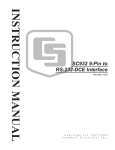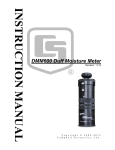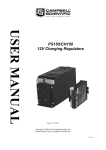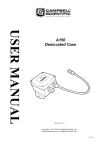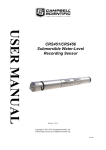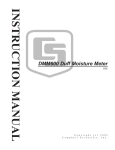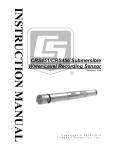Download Campbell PS100 User guide
Transcript
PS100, CH100 and BPE-ALK Power Supplies User Guide Issued 12.12.12 Copyright © 2001-2012 Campbell Scientific Ltd. CSL 274 Guarantee This equipment is guaranteed against defects in materials and workmanship. This guarantee applies for twelve months from date of delivery. We will repair or replace products which prove to be defective during the guarantee period provided they are returned to us prepaid. The guarantee will not apply to: • Equipment which has been modified or altered in any way without the written permission of Campbell Scientific • Batteries • Any product which has been subjected to misuse, neglect, acts of God or damage in transit. Campbell Scientific will return guaranteed equipment by surface carrier prepaid. Campbell Scientific will not reimburse the claimant for costs incurred in removing and/or reinstalling equipment. This guarantee and the Company’s obligation thereunder is in lieu of all other guarantees, expressed or implied, including those of suitability and fitness for a particular purpose. Campbell Scientific is not liable for consequential damage. Please inform us before returning equipment and obtain a Repair Reference Number whether the repair is under guarantee or not. Please state the faults as clearly as possible, and if the product is out of the guarantee period it should be accompanied by a purchase order. Quotations for repairs can be given on request. It is the policy of Campbell Scientific to protect the health of its employees and provide a safe working environment, in support of this policy a “Declaration of Hazardous Material and Decontamination” form will be issued for completion. When returning equipment, the Repair Reference Number must be clearly marked on the outside of the package. Complete the “Declaration of Hazardous Material and Decontamination” form and ensure a completed copy is returned with your goods. Please note your Repair may not be processed if you do not include a copy of this form and Campbell Scientific Ltd reserves the right to return goods at the customers’ expense. Note that goods sent air freight are subject to Customs clearance fees which Campbell Scientific will charge to customers. In many cases, these charges are greater than the cost of the repair. Campbell Scientific Ltd, Campbell Park, 80 Hathern Road, Shepshed, Loughborough, LE12 9GX, UK Tel: +44 (0) 1509 601141 Fax: +44 (0) 1509 601091 Email: [email protected] www.campbellsci.co.uk PLEASE READ FIRST About this manual Please note that this manual was originally produced by Campbell Scientific Inc. primarily for the North American market. Some spellings, weights and measures may reflect this origin. Some useful conversion factors: Area: 1 in2 (square inch) = 645 mm2 Length: 1 in. (inch) = 25.4 mm 1 ft (foot) = 304.8 mm 1 yard = 0.914 m 1 mile = 1.609 km Mass: 1 oz. (ounce) = 28.35 g 1 lb (pound weight) = 0.454 kg Pressure: 1 psi (lb/in2) = 68.95 mb Volume: 1 UK pint = 568.3 ml 1 UK gallon = 4.546 litres 1 US gallon = 3.785 litres In addition, while most of the information in the manual is correct for all countries, certain information is specific to the North American market and so may not be applicable to European users. Differences include the U.S standard external power supply details where some information (for example the AC transformer input voltage) will not be applicable for British/European use. Please note, however, that when a power supply adapter is ordered it will be suitable for use in your country. Reference to some radio transmitters, digital cell phones and aerials may also not be applicable according to your locality. Some brackets, shields and enclosure options, including wiring, are not sold as standard items in the European market; in some cases alternatives are offered. Details of the alternatives will be covered in separate manuals. Part numbers prefixed with a “#” symbol are special order parts for use with non-EU variants or for special installations. Please quote the full part number with the # when ordering. Recycling information At the end of this product’s life it should not be put in commercial or domestic refuse but sent for recycling. Any batteries contained within the product or used during the products life should be removed from the product and also be sent to an appropriate recycling facility. Campbell Scientific Ltd can advise on the recycling of the equipment and in some cases arrange collection and the correct disposal of it, although charges may apply for some items or territories. For further advice or support, please contact Campbell Scientific Ltd, or your local agent. Campbell Scientific Ltd, Campbell Park, 80 Hathern Road, Shepshed, Loughborough, LE12 9GX, UK Tel: +44 (0) 1509 601141 Fax: +44 (0) 1509 601091 Email: [email protected] www.campbellsci.co.uk Contents 1. Introduction ........................................................................ 1 2. BPE-ALK Alkaline Power Supply ...................................... 1 3. PS100 Lead-Acid Power Supply ....................................... 3 3.1 Description ......................................................................................................... 3 3.2 AC Adapters (Transformers) ............................................................................. 6 3.2.1 AC-ADAPT ............................................................................................. 6 3.2.2 AC-ADAPT2 ........................................................................................... 6 3.2.3 Installation of the Adapter........................................................................ 7 3.3 Installation of the Power Supply Unit................................................................ 7 3.4 Charging ............................................................................................................ 9 3.5 Use of Backup Battery ..................................................................................... 10 3.6 Fuse Protection ................................................................................................ 10 4. PS100-A100 Power Supply with Null Modem Ports ...... 10 5. A105 12V Terminal Expansion Adapter .......................... 11 6. Solar Panels ...................................................................... 12 Figures 1. PS100 Power Supply with optional A100 null modem port fitted ..................... 3 2. CH100 Charger mounted alongside a BP24 in a typical logger-enclosure configuration ................................................................................................... 4 3. Wiring to Charger ............................................................................................... 8 4. Simplified Charging Circuit Schematic .............................................................. 8 5. Null Modem Connections ................................................................................. 11 6. A105 Adapter.................................................................................................... 11 Tables 1. Typical Alkaline Battery Service as a Function of Temperature ........................ 3 2. Specifications ...................................................................................................... 5 3. Typical Battery Capacity for Lead-acid Batteries as a Function of Temperature ................................................................................................ 6 4. Solar Panel Specifications ................................................................................ 12 PS100, CH100 & BPE-ALK Power Supplies Please refer to the relevant instruction manual for further information on the use of these power supplies with specific Campbell Scientific equipment. Details of our intelligent PS200/CH200 Charging Regulators are described in a separate manual. 1. Introduction The PS100 is a 12-volt power supply that includes a charging regulator and a 7 amp hour battery. The CH100 is a charging regulator that is used with larger Campbell Scientific battery packs such as the BP12, BP17 or BP24 or with a usersupplied battery. Charging power is typically supplied by an AC transformer or an unregulated solar panel. The PS100 and CH100 each have one adapter connector that will allow connecting one of the following adapters. The A100 Null Modem Adapter has two 9-pin connectors that provide a null modem for use in a site, without a datalogger. The A100 connects and powers two Campbell Scientific peripherals that would normally be connected to a datalogger. These peripherals are typically modems linking different communications technologies; e.g., telephone to radio. A PS100 sold fitted with a A100 adaptor is sold as a PS100-A100. The A105 Additional 12 V Terminals Adapter may be used to provide additional 12 V and ground terminals where the power supply is used to power several devices. NOTE To prevent people from getting burned, an ABS plastic cover [CSI #18688] sits on the heatsink of a PS100 or CH100. The cover is fastened to the heatsink via a #4-40 x .250 Pan Phillips screw [#395]. The cover must be removed to attach an A100 or A105 adapter. Some early models of the PS100 and CH100 did not include the cover and do not have a place to attach it. A number of Power Supply options are available with either alkaline or lead-acid batteries. A unit that has the suffix -ALK to denote the battery type is a nonrechargeable alkaline supply. 2. BPE-ALK Alkaline Power Supply The BPE-ALK has eight alkaline D-cells mounted in a simple carrier. The BPE-ALK can also be used with a lead-acid battery connected in parallel to the datalogger; in this case the alkaline batteries act as a backup. The BPE-ALK incorporates a low voltage drop diode which prevents any paralleled battery discharging into the alkaline batteries. 1 PS100, CH100 & BP-ALK Power Supplies Before installing the alkaline batteries, connect all necessary sensor leads, control lines and power leads. The datalogger can be turned off and on by disconnecting and reconnecting the in-line connector between the BPE-ALK and the datalogger. NOTE The battery connector and in-line connectors fitted to all power supply variants are 2-pole versions of the Molex Mini-Fit Jnr. series. You can remove and replace battery packs from all current dataloggers without losing your stored program or data. However, if you wish to replace the batteries without interrupting a current running program, do the following: 1. Connect an external battery directly to the datalogger 12V terminals. 2. Remove the old batteries. 3. Replace with new alkaline D-cell batteries. 4. Remove the external battery. Where this is to be done on a regular basis a second, spare alkaline battery pack can be bought. Each pack is supplied with a spare set of connection leads including a mating connector and free end for wiring into the datalogger. This free end can be detached and permanently wired into the datalogger resulting in two connectors attached to the datalogger. To change the battery pack, simply plug the new pack into the spare battery connector and remove the old one. A fresh set of eight alkaline D cells provides 12.4V to the datalogger with a nominal rating of 10Ah capacity at 20°C. The amp-hour rating decreases with temperature, as shown in Table 1. The battery voltage can be monitored by using the appropriate datalogger programming instruction. Please note that this will be approximately 0.3V less than the actual battery voltage because of the diode incorporated in the battery carrier. Replace the alkaline cells before the battery voltage (as seen at the datalogger terminals) drops below 9.6V. 2 User Guide Table 1 Typical Alkaline Battery Service as a Function of Temperature Temperature (°C) 20 - 50 15 10 5 0 -10 -20 -30 NOTE % of 20°C Service 100 98 94 90 86 70 50 30 This data is based on one ‘D’ cell under conditions of 50mA current drain with a 30 ohm load. As the current drain decreases, the percent service improves for a given temperature. 3. PS100/CH100 Lead-Acid Power Supplies 3.1 Description The PS100 power supply includes a 12V, 7.0Ah lead-acid battery and a temperature-compensated charging circuit. The unit can be fitted with optional modules, such as the A100 null modem adaptor (see section 5). Figure 1 PS100 Power Supply with optional A100 null modem port fitted This supply is designed to power the datalogger continuously. Therefore, an AC transformer (optional) or solar panel should be connected to the PS100 at all times. The charging source powers the datalogger while float charging the leadacid batteries. The internal lead-acid battery powers the datalogger if the charging source is interrupted. NOTE To prevent people from getting burned, an ABS plastic cover sits on the heatsink of a PS100 or CH100. The cover is fastened to the heatsink via a #4-40 x .250 Pan Phillips screw [#395]. The cover must be removed to attach an A100 or A105 adapter. Some early models of the PS100 and CH100 did not include the cover and do not have a place to attach it. 3 PS100, CH100 & BP-ALK Power Supplies The CH100 has an identical charging circuit to the PS100 but does not include an attached battery carrier or battery (see Figure 2). It is commonly used with the BP12, BP17 or BP24 battery packs or an external battery. The BP packs comprise a carrier to hold the supplied lead acid battery onto the chassis plate of an enclosure. The CH100 is generally mounted alongside the BP on the chassis plate. CH100 charger/regulator BP17 Figure 2(a) CH100 charger mounted alongside a BP17 in a typical loggerenclosure configuration Figure 2(b) CH100 charger mounted alongside a BP17 in a typical loggerenclosure configuration 4 User Guide The PS100 and CH100 specifications are given in Table 2, and the performance of the battery with temperature is given in Table 3. Table 2 Specifications Lead-Acid Battery fitted to the PS100 Battery Type: Float Life @ 25°C: Shelf Life, full charge: Yuasa NP7-12 5 years typical Check twice yearly Dimensions (H x W x D) PS100: CH100: 70 x 190 x 80 mm 102 x 70 x 39 mm Weight PS100: CH100: 3.1 kg 158 g Charger circuit (applies to CH100 too) Charge technique: Fixed voltage 14V nominal (varies with temperature) Charge Time (AC Source): 40 hr full charge, 20 hr 95% charge (7Ah battery, longer for larger batteries) Maximum charger input voltage: 25V DC or 22V AC (RMS) Maximum sustainable charge current with unlimited current input (@ 25°C 18V input, 14V output): 1.2A typical Maximum output current to Terminal from battery & charger: 12V, 1.85A Minimum voltage drop from charge input to battery: 2.8V Recommended minimum charge voltage: 17V at 25°C AC-ADAPT Transformer Input: Isolated Output: 230V AC, 50Hz 18V AC @ 1.2A max. AC-ADAPT2 Transformer Input: Isolated Output: 230V AC, 50Hz 18V AC @ 2A max. Standalone Battery Packs typically used with CH100 Operating Temperature Range: -40 to +60°C BP12 12 Amp hours BP17 17 Amp hours BP24 24 Amp hours 5 PS100, CH100 & BP-ALK Power Supplies Table 3 Typical Battery Capacity for Lead-acid Batteries as a Function of Temperature Temperature (°C) % of 20°C capacity NP7-12 40 110 7.7 20 100 7 0 84 5.9 -20 72 5.0 N.B. these figures only apply to low discharge rates. CAUTION Capacity (Ah) NP12-12 13.2 12 10.0 8.6 NP17-12 18.7 17 14.2 12.2 NP24-12 26.4 24 20.2 17.3 It is recommended that the batteries should not be deeply discharged below -20°C as there is a risk of ice formation within the battery which can cause permanent damage. 3.2 AC Adapters (Transformers) Two different 230V adapters are available from Campbell Scientific Limited in Europe for use with the lead-acid power supply units. They have different characteristics in use as explained below. Adaptors with different AC supply voltages are available to special order. 3.2.1 AC-ADAPT The AC-ADAPT is only suited for desktop use in low current applications. It can provide up to 1.2A. If the transformer unit overheats, which is only likely to occur if the output is short circuited, a safety mechanism will shut it down. In this unlikely event, reset the safety mechanism manually by removing AC power, tracing and eliminating the cause of the short circuit, and allowing the transformer to cool before re-connecting to the mains supply. The AC-ADAPT is provided with a fixed length of cable on the output side. Many installations will require this cable to be extended using a suitable length of compatible cable and an in-line connector. This extension cable is not supplied by Campbell Scientific unless specifically ordered. 3.2.2 AC-ADAPT2 The AC-ADAPT2 transformer is suitable for permanent installations which require a wall mounted unit. It is capable of providing more current than the charger unit needs and so is able to recharge batteries at the maximum rate, and still provide high current levels to equipment via the power supply. If the transformer unit overheats, which is only likely to occur if the output is short circuited, a safety mechanism will shut it down. In this unlikely event, reset the safety mechanism manually by removing AC power, tracing and eliminating the cause of the short circuit, and allowing the transformer to cool before reconnecting to the mains supply. The AC-ADAPT2 is not provided with output cable unless specifically ordered. The adapter is fitted with two screw-down terminals for you to connect a suitable length of cable as required for your application. To fit the cable to the 6 User Guide AC-ADAPT2, simply strip an appropriate length of the cable sheath, and secure the wire under the screw terminals. 3.2.3 Installation of the Adapter All low voltage power cables should have two cores at least 22SWG (0.71mm) thick. You may find that standard AC power cable is suitable. The cable run from the AC adapter to the charger module can be extended for several hundred metres if necessary, but if high current demands are anticipated, use thicker cable to prevent significant voltage drop. If the cable runs through areas where there might be a chance of electromagnetic interference, the use of a screened cable is advised, where the screen is connected at one end only (for example to the enclosure grounding point). When installing the cable within an enclosure, it is best to route the power input cables as far as possible from the signal cables in order to avoid noise injection into the signal cables. It may also be advisable to use screened power cable if high current is being taken from the AC-ADAPT2, as the current flowing in the power cable will cause radiation of 50Hz noise. CAUTION For safety reasons, both the AC-ADAPT and AC-ADAPT2 adapters should always be installed in a dry, condensationfree environment. Where the AC supply is some distance from the datalogger installation, it is recommended that the AC adapter is mounted in a dry situation adjacent to the AC power outlet, and only the safer, low-voltage, cable is extended from the adapter to the datalogger enclosure. 3.3 Installation of the Power Supply Unit The power supply units are designed to be mounted on a chassis plate using the four corner mounting holes. Fittings are provided for mounting to a Campbell Scientific enclosure chassis. To avoid damage during shipping, lead-acid batteries are sometimes packed separately. Install the battery into the carrier and connect the battery lead to the battery connector on the charger unit, or, if no charger is being used, connect to the appropriate in-line power connector. You should also check the integrity of any in-line power connectors and the power plug on the datalogger itself before powering up the system. When attaching wires to a CH100 charger module, allow enough spare wire to ensure easy removal of the battery at a later date. 7 PS100, CH100 & BP-ALK Power Supplies To Battery From Transformer or Solar Panel To Datalogger or Peripherals Figure 3. Wiring to Charger BATT INT EXT CHG Regulator IN 3A Thermal Fuse ON OUT OFF Charging CHG CHG +12 +12 Figure 4. Simplified Charging Circuit Schematic 8 These look identical when unplugged User Guide 3.4 Charging The 12 volt and ground terminals on the power supplies are for supplying power to the datalogger or other 12 volt devices. A lead is supplied fitted with an in-line connector to connect to such a device. The in-line connector is the method of turning off power to the datalogger. The two terminals labelled ‘CHARGE’ are for connecting an AC adapter or solar panel to charge the lead-acid batteries. The charge input can be either AC or DC, and it does not matter which terminal is positive or negative. The voltage input must be within the range 16 to 26V DC, or 16 to 26V AC RMS. A transzorb provides transient protection to the charging circuit. A sustained input voltage in excess of 40V will cause the transzorb to limit voltage. Some solar panels and AC adapters are supplied fitted with a connector. This connector must be cut off so that the two wires can be inserted directly into the two CHARGE terminals. The red light (LED) on the charger unit comes on when an external charging supply is connected. NOTE NOTE Illumination of this LED does not guarantee that there is sufficient charge entering the battery to stop the battery discharging; it only indicates successful connection of the charging source. If the battery is fully charged first, it may be stored for up to six months. A battery that has been stored without charging should be given a ‘top-up charge’ by charging it in its carrier/charger unit from an AC source for one day before being placed into service. There are inherent hazards associated with the use of sealed lead-acid batteries. Under normal operation, lead-acid batteries generate only a very small amount of hydrogen gas. This gaseous by-product is generally insignificant because the hydrogen dissipates naturally before build-up to an explosive level (4%) occurs. However, if the batteries are shorted or overcharging takes place, hydrogen gas may be generated at a rate sufficient to create a hazard. Campbell Scientific therefore makes the following recommendations: WARNING A PS100 or any supply equipped with lead-acid batteries should never be used in applications requiring intrinsically safe equipment and should not be housed in a gas-tight enclosure. Campbell Scientific’s ENC 10/12 and 12/14 enclosures are supplied fitted with a porous vent plug in a cable gland on the base of the enclosure. It is recommended that this is left in place when using a lead-acid battery as it will prevent pressure build-up in the event of gas release from the battery. It is recommended that the battery voltage is monitored using the appropriate datalogger programming instruction. Add this instruction to your programs to keep track of the state of the power supply. If the system voltage level consistently decreases, some element(s) of the charging system has failed or the charging source is not providing adequate current. It should be noted though that the terminal voltage of lead-acid batteries varies with temperature. 9 PS100, CH100 & BP-ALK Power Supplies NOTE The datalogger measures the voltage at its 12V port, not the voltage of the lead-acid battery. External power sources must therefore be disconnected from the charging circuit in order to measure the actual lead-acid battery voltage. 3.5 Use of Backup Battery The charger/regulator is fitted with two connectors labelled ‘BATTERY’. One of these sockets is normally used for connection of the internal battery. The other socket is provided mainly for the connection of a secondary backup battery, which could be an alkaline battery pack. This pack would normally only be connected to allow the internal lead-acid battery to be exchanged. The two terminals are diode protected. Under certain circumstances a larger lead-acid battery can be permanently connected to one of these sockets, with the internal battery disconnected. You should be aware that the charger circuit is designed for float charging relatively small lead-acid batteries. Trying to recharge a discharged, large external lead-acid battery may be successful but will result in a very slow rate of charge and a certain amount of heat generation by the charger circuit. If the external battery is being discharged at a significant rate, then current limiting circuits in the charger may prevent enough charge reaching the battery to keep it fully charged. 3.6 Fuse Protection A thermal fuse (1.85A) in the power circuit limits current flow from the battery to the 12V terminal. If excessive current is drawn, the fuse gets hot, increases in resistance, and limits the current. When the problem is fixed, the fuse cools and the resistance decreases, eventually allowing current to pass. When excessive current is drawn due to shorting the power leads together, for example, allow 10 to 15 seconds for the fuse to cool before reconnecting power. 4. PS100-A100 Power Supply with Null Modem Ports The PS100-A100 12V Lead-Acid Power Supply with Charging Regulator and Null Modem Ports (see Figure 1) is used when 5V is needed to power external modems, in addition to the normal capabilities of the PS100. The PS100-A100 supplies 5V to pin 1 of two 9-pin null modem ports, which protrude from the side of the case. Otherwise the capabilities and functions are identical to the PS100. A common use for the PS100-A100 is in radio telemetry networks. The maximum current drain on the 5V supply of the PS100-A100 is 150mA. 10 User Guide Figure 5. Null Modem Connections CAUTION This cannot be used as a null modem between two RS232 devices. 5. A105 12V Terminal Expansion Adapter The A105 adapter adds four 12-V terminals and four ground terminals to a CH100 or PS100 (see Figure 6). The extra terminals make it easier to wire multiple continuously powered 12-Vdc devices to the power supply. Figure 6. A105 Adapter 11 PS100, CH100 & BP-ALK Power Supplies 6. Solar Panels Auxiliary photovoltaic power sources such as the SP5, SP10 and SP20 Solar Panels may be used to maintain the charge on lead-acid batteries. Table 4 Solar Panel Specifications Typical Peak Power (Watts) Current @ Peak (Amps) Amp Hrs/week NOTE SP5 4.5 0.27 6.4 SP10 10 0.58 14.4 SP20 20 1.17 26.4 These specifications assume 1kW/m2 illumination at a panel cell temperature of 25°C. Individual panel performance may vary as much as 10%. When selecting a solar panel, a rule-of-thumb is that on a stormy overcast day the panel should provide enough charge to meet the system current drain (assume 10% of average annual global radiation, kW/m2). Specific site information, if available, could strongly influence the solar panel selection. For example, local effects such as mountain shadows, fog from valley inversion, snow, ice, leaves, birds, etc. shading the panel should be considered. Please refer to Campbell Scientific Technical Note 12 for a more detailed analysis of how to estimate power consumption and solar panel size. The SP5 and SP10 are most commonly used with the PS100 power supply. The SP20 can also be used with the PS100 in many circumstances – for example, in less favourable climatic conditions, and in some Northern installations, where solar radiation can be low. It can also be used in some high current applications, but it should be noted that the reserve capacity of the PS100 battery may be a limiting factor. The CH100 or CH200 plus a large capacity battery pack is better suited to such applications. NOTE The SP20 or large panels when connected to the PS100, must not be used to charge a large external battery in parallel with the internal 7 Ah battery. Note also that the SP20R (the version of the SP20 fitted with a shunt regulator) must not be connected to these chargers. This combination will not result in successful battery charging. Please see the Solar Panels User Guide (supplied with orders for solar panels from Campbell Scientific) for further installation and technical details. If you intend to use solar panels from other manufacturers (i.e. not supplied by Campbell Scientific), choose a panel which gives its optimum power output at a voltage greater than 16V. Some cheaper 12V panels show a sharp decline in efficiency above 14V DC. 12 CAMPBELL SCIENTIFIC COMPANIES Campbell Scientific, Inc. (CSI) 815 West 1800 North Logan, Utah 84321 UNITED STATES www.campbellsci.com • [email protected] Campbell Scientific Africa Pty. Ltd. (CSAf) PO Box 2450 Somerset West 7129 SOUTH AFRICA www.csafrica.co.za • [email protected] Campbell Scientific Australia Pty. Ltd. (CSA) PO Box 444 Thuringowa Central QLD 4812 AUSTRALIA www.campbellsci.com.au • [email protected] Campbell Scientific do Brazil Ltda. (CSB) Rua Luisa Crapsi Orsi, 15 Butantã CEP: 005543-000 São Paulo SP BRAZIL www.campbellsci.com.br • [email protected] Campbell Scientific Canada Corp. (CSC) 11564 - 149th Street NW Edmonton, Alberta T5M 1W7 CANADA www.campbellsci.ca • [email protected] Campbell Scientific Centro Caribe S.A. (CSCC) 300N Cementerio, Edificio Breller Santo Domingo, Heredia 40305 COSTA RICA www.campbellsci.cc • [email protected] Campbell Scientific Ltd. (CSL) Campbell Park 80 Hathern Road Shepshed, Loughborough LE12 9GX UNITED KINGDOM www.campbellsci.co.uk • [email protected] Campbell Scientific Ltd. (France) 3 Avenue de la Division Leclerc 92160 ANTONY FRANCE www.campbellsci.fr • [email protected] Campbell Scientific Spain, S. L. Avda. Pompeu Fabra 7-9 Local 1 - 08024 BARCELONA SPAIN www.campbellsci.es • [email protected] Campbell Scientific Ltd. (Germany) Fahrenheitstrasse13, D-28359 Bremen GERMANY www.campbellsci.de • [email protected] Please visit www.campbellsci.com to obtain contact information for your local US or International representative.

























